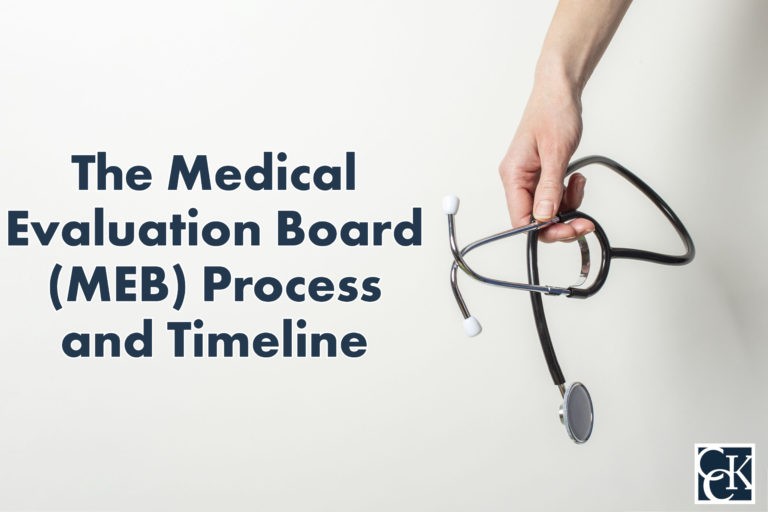The Medical Evaluation Board (MEB) Process and Timeline

CCK Law: Our Vital Role in Veterans Law
Throughout their service, many servicemembers experience injuries or develop health conditions. If a servicemember develops a medical condition that prevents them from performing their military duties or making a full return to duty within one year, the servicemember may be referred to a Medical Evaluation Board (MEB). Continue reading for a full look at the Medical Evaluation Board process.
How Does the Medical Evaluation Board Work?
In order to decide if a potentially disabled service member can return to duty, or be separated from service, they will need to be evaluated by the Integrated Disability Evaluation System, or IDES. IDES is a set of standards and procedures set forth by the Department of Defense and VA to determine whether a service member can be discharged as a result of their disability and to implement that transition as seamlessly as possible.
If a service member is being evaluated by IDES, they will be assigned a Physical Evaluation Board Liaison Officer (PEBLO). The Physical Evaluation Liaison Officer is meant to help the servicemember understand how they are going to be evaluated through IDES and prepare for the MEB evaluation. The PEBLO should be knowledgeable about the MEB process, the servicemember’s rights and responsibilities, and the informal physical evaluation board process (IPEB). The PEBLO can also ensure that the servicemember’s case is handled in a timely manner, as they schedule and convene the MEB and complete the veteran’s file.
Additionally, the PEBLO will work closely with VA’s Military Services Coordinator (MSC), whose job is to schedule medical exams the servicemember may need and assist with claims for VA disability benefits. Once exams are completed, the records will be sent to the Medical Evaluation Board.
The Medical Evaluation Board always consists of at least two medical doctors. If the person has a mental health condition, then the Medical Evaluation Board must also have a mental health care provider or a psychologist. Additionally, the MEB may also review any treatments the servicemember received for their medical condition while on active duty. The MEB will likely review potential limitations and long-term effects or disabilities.
What Documents are Included in the Medical Evaluation Board?
Narrative Summary
A narrative summary, or NARSUM, is a document prepared by a physician who can describe the servicemember’s history and the severity of their disability or health condition. The NARSUM will detail how the servicemember’s medical condition affects their ability to perform their service duties. Additionally, it will include an assessment as to whether the condition is service-related.
Commander’s Statement
As part of the process, the servicemember’s commanding officer will also submit a statement. The commanding officer can speak to the servicemember’s ability to perform their duties. The PEBLO should arrange for the commanding officer to submit this statement.
Personal Statement
In addition to the commanding officer’s statement, the servicemember may submit their own statement to the Medical Evaluation Board file. This personal statement can address the servicemember’s medical condition, the impacts of the medical condition on daily life, and any gaps in the documentation. The United States Navy has a template designed to help servicemembers draft their statements which includes sections on the servicemember’s military background, the onset of injury or illness, treatment history overview, and continuing symptoms or limitations. Personal statements present an opportunity for the servicemember’s voice to be heard.
What is the Medical Evaluation Board Process?
As part of the MEB process, the Medical Evaluation Board will meet to go over the servicemember’s file, which includes all the documentation described above that was submitted. The MEB will use this documentation to evaluate whether the servicemember’s health condition renders them unable to perform their military service.
After the evaluation is completed, the MEB will create a report called the Medical Evaluation Board Proceedings. This report will include the determination that the MEB made based on the medical evidence and supporting documentation in the file. Generally, there are two determinations that can be made:
- Servicemember meets medical acceptability standards—If the Medical Evaluation Board determines that the servicemember’s health condition does meet the medical acceptability standards for their branch of service, the MEB process will end there. However, the veteran may still be able to file a claim for VA disability benefits once their service is concluded.
- Servicemember does not meet medical acceptability standards—Alternately, it may be determined that the servicemember’s health condition does not meet service-wide medical retention standards. At this point, the Medical Evaluation Board will then refer the case to the Physical Evaluation Board (PEB). At this point, the MEB portion of the process is typically complete. The PEB will then take the case from there, since the MEB has met its goal of determining whether the servicemember’s health condition impacts their ability to perform their military duties.
Physical Evaluation Board Process
The Physical Evaluation Board process will begin once the Medical Evaluation Board process has concluded. The PEB may be formal or informal. If the PEB is informal, it could be referred to as an IPEB, or informal physical evaluation board.
The Physical Evaluation Board’s job is to make a determination regarding the servicemember’s fitness for duty, as well as eligibility for VA disability compensation benefits. In order to be eligible for these benefits, the PEB will need to determine if the health condition is service-related. If it is service-related, the PEB can also issue a disability rating. The disability rating will range from 0 to 100 percent and correlate directly with the amount of compensation.
The Physical Evaluation Board may make the determination that the service member cannot be retained in service and should be separated, as well as if the service member will receive severance pay. The PEB can also place the servicemember on the Department of Defense Temporary Disability Retired List (TDRL).
The servicemember retains the right to appeal the PEB’s decision, should they disagree with the board’s findings. The servicemember can also submit a rebuttal to the PEB’s findings.
Keys to Preparing for the MEB Process
- Communication — Communication is one of the key aspects of the Medical Evaluation Board process. It is crucial that servicemembers stay in close communication with their Physical Evaluation Board Liaison Officer and VA Military Service Coordinator. Maintaining communication ensures that the servicemember will not miss any exams or deadlines to submit paperwork. Servicemembers should be sure to inform their PEBLO if they receive any new test results or exams so that the records can be submitted to the MEB.
- Attendance — Attendance is another crucial element of the MEB process. Servicemembers need to attend exams so that the test results can be submitted, allowing the MEB to make the most informed evaluation. If the service member does not attend exams, it could impact their ability to receive VA disability benefits after they leave service.
How Long Will the MEB Process Last? A Timeline
On average, the MEB process takes roughly about 100 days. However, this is not definitive, meaning that some cases may take longer, while others could be resolved more quickly. Any delays in scheduling exams could add to wait times at the MEB.
Additionally, another delay could occur if the Physical Evaluation Board determines that there is not enough information in the report issued by the MEB. If that is the case, the PEB may send the servicemember’s case back to the MEB to be re-evaluated.
Documentation can be crucial in preventing any delays, so servicemembers may desire to keep copies of the documents they submit. This can also be helpful if the servicemember desires to file a claim for VA disability benefits after being discharged.
About the Author
Share this Post
